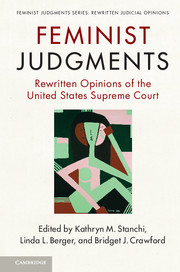How would U.S. Supreme Court opinions change if the justices used feminist methods and perspectives when deciding cases? That is the central question that we sought to answer by bringing together a group of scholars and lawyers to carry out this project. To answer it, they would use feminist theories to rewrite the most significant gender justice cases decided by the U.S. Supreme Court from the passage of the final Civil Rights Amendment in 1870 to the summer of 2015.
As an initial matter, we provided no guidance to our contributors on what we meant by “feminism.” We wanted our authors to be free to bring their own vision of feminism to the project. Yet it would be disingenuous to suggest that we ourselves do not have a particular perspective on what “feminism,” “feminist reasoning,” or “feminist methods” are. Indeed, without such a perspective, we would not have undertaken the project.
We recognize “feminism” as a movement and perspective historically grounded in politics, and one that motivates social, legal, and other battles for women's equality. We also understand it as a movement and mode of inquiry that has grown to endorse justice for all people, particularly those historically oppressed or marginalized by or through law. We believe that “feminism” is not the province of women only, and we acknowledge and celebrate the multiple, fluid identities contained in the category “woman.” Within this broad view, we acknowledge that feminists can disagree (and still be feminist) and that there are no unitary feminist methods or reasoning processes. So when we refer to feminist methods or feminist reasoning processes, we mean “methods” and “reasoning processes” plural, all the while acknowledging that there is a rich and diverse body of scholarship that has flourished under the over-arching label “feminist legal theory.” Indeed, those are the methods and reasoning processes examined and employed by many of the authors represented in the book.
Nevertheless, in shaping the project from its early stages through the finished pages, we as editors have been motivated by a broad and expansive view of what “feminism” is. This capacious understanding undoubtedly shaped the project in many ways, including our choice of cases, our selection of authors, and our edits, even if we did not define feminism for our contributors.


